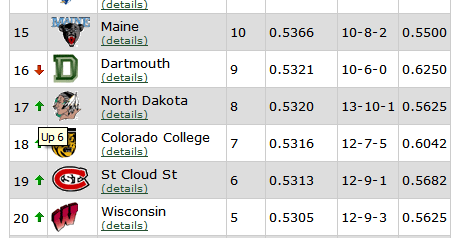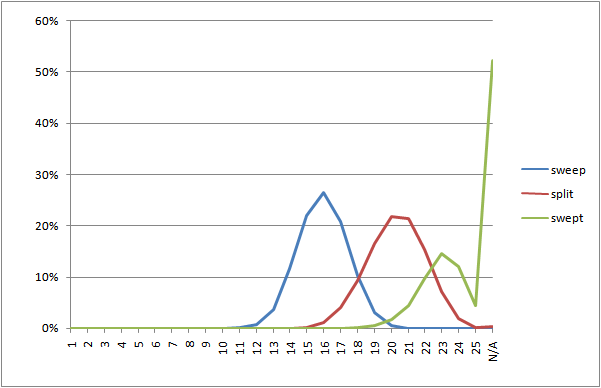Did you know that the PWR table shows you the movement since last week? The little arrow (green, pointing up next to UND) shows you the direction of the move, and the text shows the magnitude. UND climbed 6 spots, from 23 to 17, by sweeping the Gophers.

Wow, who saw that coming? That gave me an idea that I think might be the first really good use of the PWR Predictor. A question I’m certainly asking myself now, and I’m sure I’m not alone, is:
What will UND’s PWR be next Tuesday if UND sweeps Tech? What if Tech sweeps the Sioux?
Well, here we go…
Probability of UND’s PWR as of Jan. 20, based on how it performs vs. Michigan Tech:

UND’s current PWR is 17
Here’s what the chart is telling you UND’s PWR will be:
- UND sweeps: 68% chance it’s between 15 and 17, about a 4% chance its 13 or higher, about a 4% chance it’s 19 or lower
- Split: 75% chance it’s between 19 and 22, about a 1% chance its 16 or higher, about a 2% chance it’s 2 or lower
- Tech sweeps: 50% chance UND falls out of being a TUC, 42% chance it’s between 22 and 25
Future directions
I think the chart above is a good one that is easily understood and conveys interesting information. It (or a refinement of it) is likely to be the first one that I turn into a real product — a web page that automatically updates that anyone can visit to find out this sort of information each week.
Obviously, it would be nice to be able to drill in and find out what else could happen around the league to influence where UND falls in those distributions. E.g., what else has to happen, combined with a UND sweep, for UND to jump to 9th (or fall to 23rd) in the PWR. Figuring out how to make that information accessible to interested parties is definitely something I’ll also add to the to-do list for future features of this product.
I’m still running lots of simulations and making charts, trying to find useful simulations and ways to present the results.
Background
Those wondering where these predictions come from, or interested in other presentations of PWR prediction data, should read the previous blog posts in which I introduced the PWR Predictor: